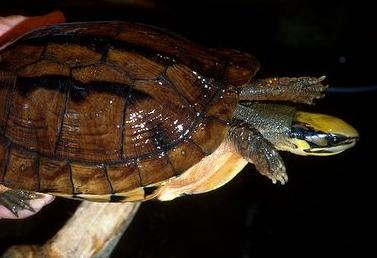Box Turtle - Chinese
Yellow Margined Box Turtle, Yellow Rimmed Box Turtle, Snake Eating Box Turtle Scientific Name: Cuora flavomarginata
Tue, 27th May, 2025 - 6:03 pm GMT
Sponsor Ads:

Alternative Name
Yellow Margined Box Turtle, Yellow Rimmed Box Turtle, Snake Eating Box Turtle Scientific Name: Cuora flavomarginataBasic Info
A small turtle with a high dome, the Chinese Box Turtle has a dark brown shell. This rich brown shade is uniform, except for the light yellow stripe on the vertebral keel and the light colored edge around the plastron. These light markings are the basis for the names "Yellow Margined Box Turtle" and "Yellow Rimmed Box Turtle." The vertebral keel is prominent and they may have two lateral keels. Unlike other turtles, which have the carapace attached to the plastron by a bony bridge, the Chinese Box Turtle has ligaments attaching the two parts of the shell. These ligaments, in addition to the hinge on the plastron, enable the turtle to close its shell very tightly when threatened. The legs of the Chinese Box Turtle are brown and its head has a pale green line bisecting the pale green head from the eye back. The apricot, pink or yellow chin and neck create a beautiful contrast. The Chinese Box Turtle has four claws on the rear feet and five on the front. It is very difficult to tell males and females apart, although males have larger, broader tails than females.
Health
The Chinese Box Turtle will do well in a large enclosure with other turtles of the same species or different species. They require a shallow pool to soak and wade in. They can be kept outdoors in temperate enclosure, provided there is plenty of shade. The enclosures should be watered daily in hot weather. Mature Chinese Box Turtles can be fed a diet of earthworms, small worms, slugs and snails. They can also be fed dry or canned cat food, fruits and vegetables. Ideal fruits are strawberries, papaya, cantaloupe and bananas, and they enjoy carrots, corn and squash. They should be provided with a source of calcium. Breeding When courting, the male extends his neck and sways it towards the female, parallel to the ground. The animals often bite and chase each other during courting. The male often smacks his lips or hisses and sometimes drools. The male will then bite the front of the female's shell. When she is still, he mounts her from the rear. The breeding period is in the spring, summer and fall. Dominant males are sometimes aggressive towards other adult males as well as towards juvenile males. Female Chinese Box Turtles nest during the daytime. They dig many holes before deciding on one to nest in. They nest between March and August. They can lay multiple clutches per season, and each clutch usually consists of two or three eggs. Smaller females will only lay one egg per clutch. They usually nest in the shade. The eggs are large, between 38 and 52 mm long. The eggs usually hatch after between 75 and 90 days of incubation at about 28 degrees Celsius. The hatchlings are large, between 31 and 44mm. The hatchlings usually begin eating in about five days. They are similar in appearance to the adults.Habitat
They live in a variety of habitats, from sub-tropical to temperate regions, and nearly always live near water.Behavior
The Chinese Box Turtle is a small, primarily terrestrial turtle. It is sometimes known as the Yellow Margined Box Turtle, Yellow Rimmed Box Turtle, Snake Eating Box Turtle or Snail Eating Box Turtle. Captive Chinese Box Turtles are usually somewhat skittish initially, but they usually settle down and make an entrancing pet. The Chinese Box Turtle, although it will enter shallow water to hunt and soak, is primarily terrestrial. They are sociable animals and have been observed in groups on the banks of streams in the mountains or swimming in still, shallow water.Origin
Indo-PacificHistory
The Chinese Box Turtle was first described in 1863 by John Edward Gray. The Taxonomy of the species has been debated since that time. Gray placed the species in the Cistoclemmys family. In the early 1900s, researchers reassigned it to the genus Cyclemys, and then in the 1930s moved it to Cuora. As recently as 1983, Ren Hirayama and Roger Bour have suggested the morphological evidence places the Chinese Box Turtle in a separate genus from Cuora. This suggestion has received both good and bad responses, but has never been disproved and today the most common scientific name for the Chinese Box Turtle is Cistoclemmys flavomarginata. The Chinese Box Turtle is being threatened in the wild because of the pet trade, which is removing them from the wild in great numbers for exportation to the United States, as well as by habitat destruction. The Chinese Box Turtle is native to Asia, particularly Taiwan, southern China and the Japanese Ryukyu Islands. While all tortoises are technically turtles, some Box Turtles are classified as Tortoises and some are classified as Turtles. On CentralPets.com we use this style of classification.Common Foods
Chinese Box Turtles are omnivorous, meaning they feed both on animal and plant matter.Sponsor Ads:
When Gandhi was asked at the end of his life what his biggest disappointment was, he replied, "The hard-heartedness of the intellectual class."
Box Turtle - Chinese
Coded by: BGID® | ALL RIGHTS RESERVED Copyright © 2000-2025
Disclaimer | Privacy | Report Errors / Contact | Credits

 President of the United States of America - Real Estate mogul, Pageant owner and now one of the most controversial men in political history.
President of the United States of America - Real Estate mogul, Pageant owner and now one of the most controversial men in political history.  Politician, US Vice President and President of the USA - Joseph Robinette Biden Jr.
Politician, US Vice President and President of the USA - Joseph Robinette Biden Jr.  versus
versus  Russia: 'The Evil Empire'? Are they all that bad or is it just the USA trying to portray Russia as bad because they are a world power with land bigger and a society very different from the USA ideal?
Russia: 'The Evil Empire'? Are they all that bad or is it just the USA trying to portray Russia as bad because they are a world power with land bigger and a society very different from the USA ideal?  Global warming has been in and out as the "latest" hot topic for many years. It is, according to modern scientists, the result of man-made industrial pollutants, clearing forested areas, agriculture, etc. But now they are thinking it started way before the Industrial Revolution...
Global warming has been in and out as the "latest" hot topic for many years. It is, according to modern scientists, the result of man-made industrial pollutants, clearing forested areas, agriculture, etc. But now they are thinking it started way before the Industrial Revolution... 
 Corona virus
Corona virus 
 Users with wide screen monitors can benefit from more content on every page.
Users with wide screen monitors can benefit from more content on every page.